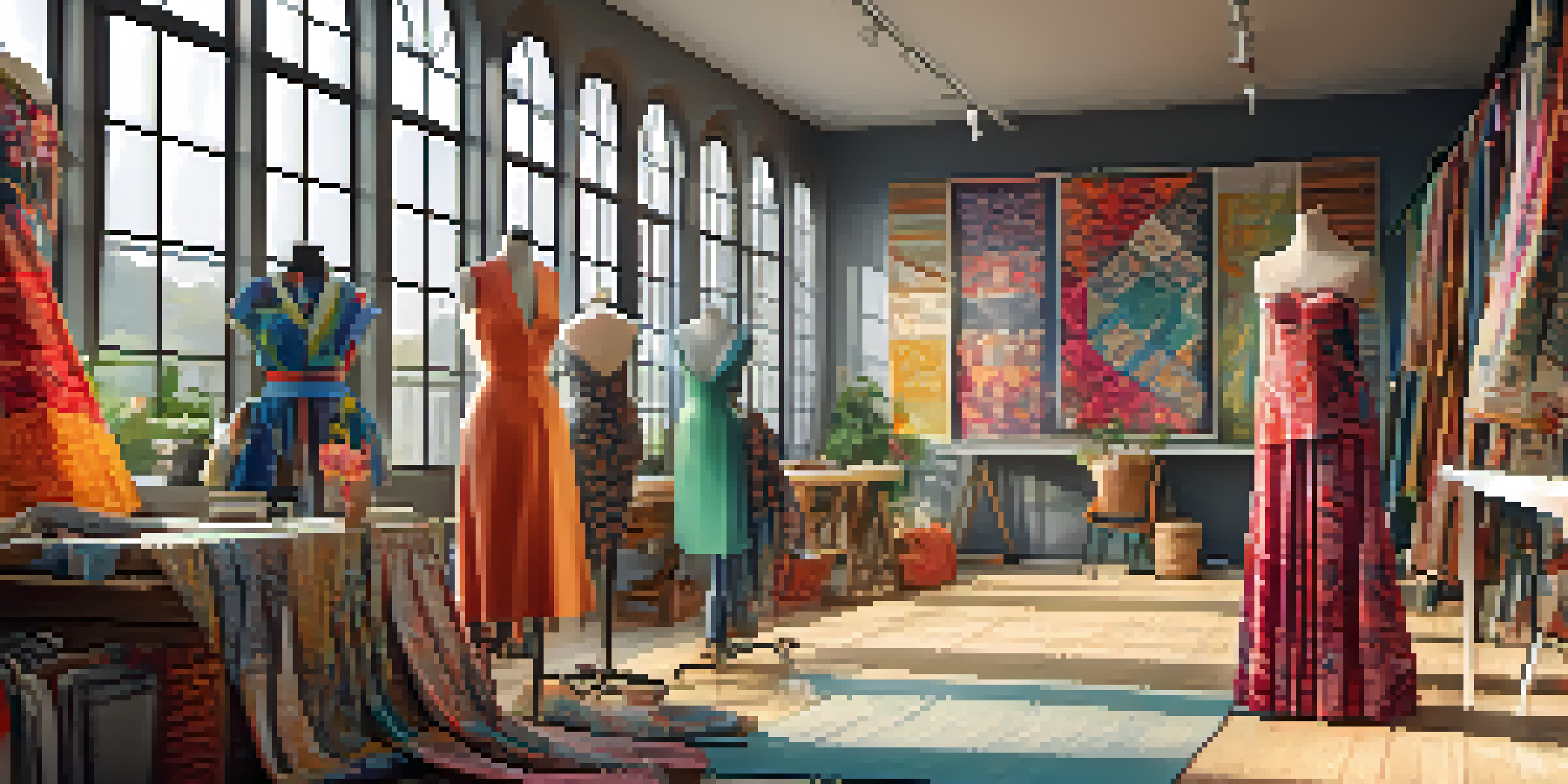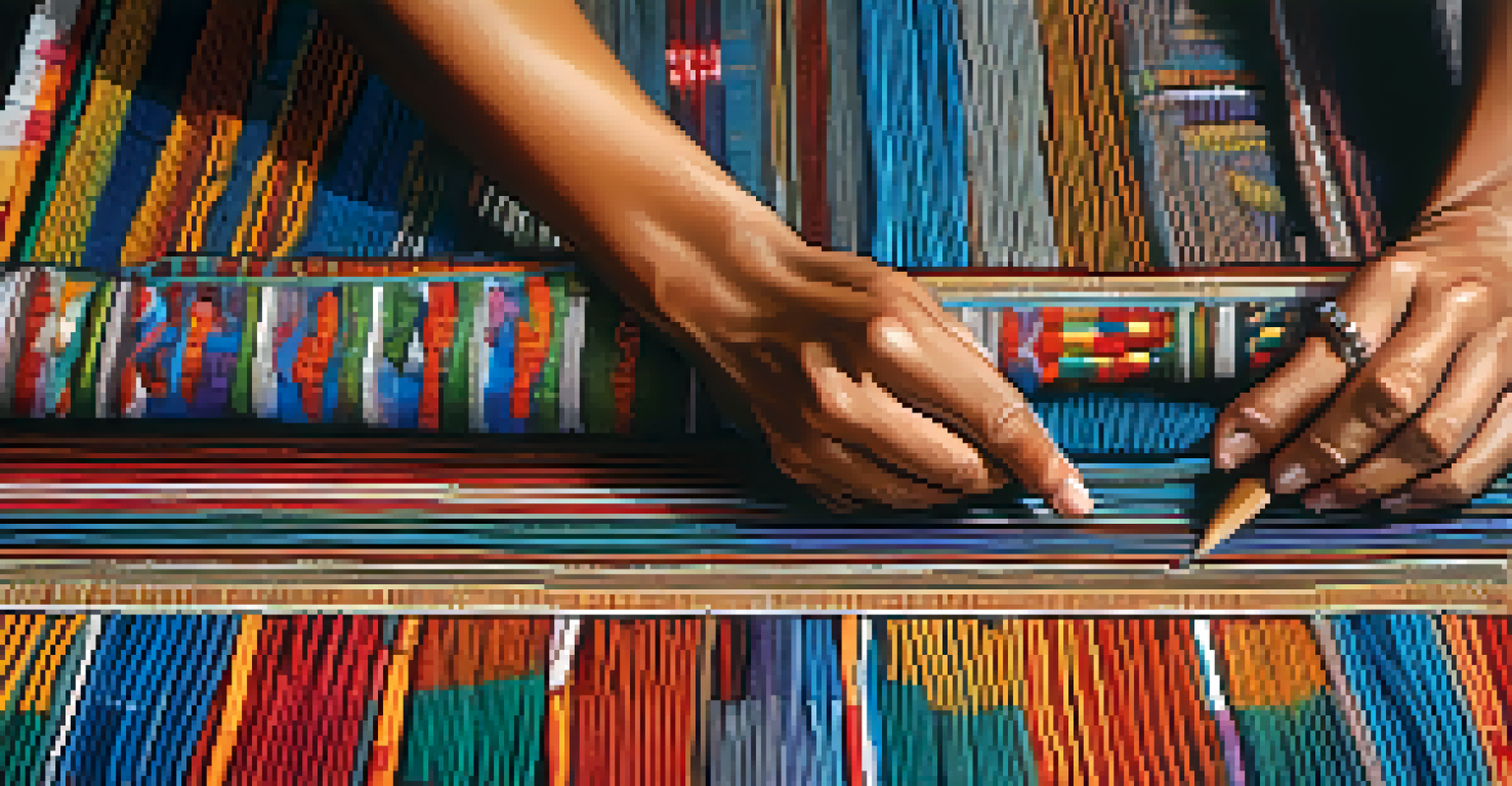Cultural Appropriation vs. Appreciation in Fashion Industry

Defining Cultural Appropriation in Fashion
Cultural appropriation in fashion refers to the adoption of elements from one culture by members of another, often without permission or understanding. This practice can lead to misrepresentation and commodification, reducing rich cultural symbols to mere trends. For example, when a designer uses traditional Indigenous patterns without acknowledging their significance, it can be seen as disrespectful. It's crucial to recognize the power dynamics at play, where marginalized cultures may feel exploited by those in positions of privilege.
Cultural appropriation is the act of taking or borrowing elements from a culture, often without understanding or respecting its significance.
The impact of cultural appropriation often extends beyond fashion, affecting the communities from which these styles are drawn. When cultural symbols are used carelessly, they can dilute their meaning and significance. Think of it as borrowing a cherished family heirloom without asking—it's not just the item itself, but the history and stories behind it that matter. Therefore, understanding the context is essential before incorporating elements from another culture into one’s fashion choices.
In a world where fashion is heavily influenced by global trends, the line between borrowing and stealing can become blurred. This is especially true when fashion houses profit from styles rooted in cultures that are not their own. Thus, being aware of cultural appropriation is the first step toward fostering a more respectful and inclusive environment within the industry.
Understanding Cultural Appreciation in Fashion
Cultural appreciation, on the other hand, involves an understanding and respect for the cultural elements being used. This means engaging with the culture in a meaningful way, often through collaboration or acknowledgment of its origins. For instance, when a designer works with artisans from a specific culture to create a collection, it showcases respect and appreciation for that culture. This approach not only honors the roots of the fashion but also supports the community involved.

Appreciation can enrich the fashion landscape by introducing diverse perspectives and aesthetics. Imagine a vibrant tapestry where each thread represents a unique culture, contributing to a beautiful and dynamic whole. This inclusivity can lead to innovative designs that celebrate rather than exploit cultural differences. It's about creating a dialogue that honors and respects the heritage of others while also allowing for artistic expression.
Cultural Appropriation Explained
Cultural appropriation in fashion involves adopting elements from another culture without permission, often leading to misrepresentation and exploitation.
Furthermore, cultural appreciation encourages consumers to be more mindful about their fashion choices. By educating themselves about the origins of certain styles and the stories behind them, individuals can make informed decisions that reflect their values. This shift towards appreciation can help dismantle harmful stereotypes and foster a more equitable fashion industry.
The Fine Line Between Appropriation and Appreciation
Navigating the thin line between cultural appropriation and appreciation can be challenging, especially in the fast-paced fashion industry. Designers and brands must be vigilant and sensitive to the cultural implications of their work. It's essential to ask questions like, 'Am I giving credit where it’s due?' or 'Am I representing this culture accurately?' These reflections can help prevent unintentional appropriation while promoting genuine appreciation.
When we appreciate culture, we honor its roots and acknowledge the stories behind it, fostering a deeper connection.
To illustrate, consider the difference between a fashion statement and a cultural statement. Wearing a piece that represents a culture, like a kimono, without context can be seen as appropriation, particularly if it's stripped of its cultural significance. However, collaborating with those who have lived experiences and understanding the cultural narratives can transform that same piece into an act of appreciation. This distinction is crucial for fostering respect in the fashion space.
Ultimately, the conversation around appropriation and appreciation is ongoing and evolving. As society becomes more aware of cultural sensitivities, fashion designers must adapt and consider the broader implications of their work. This conscious effort can lead to a more inclusive and respectful industry that celebrates diversity rather than exploiting it.
The Role of Social Media in Fashion Discussions
Social media has played a significant role in amplifying discussions about cultural appropriation and appreciation in fashion. Platforms like Instagram and TikTok provide a space for voices from various cultures to share their perspectives, allowing for greater awareness and education. This democratization of dialogue means that brands can no longer operate in a vacuum—they're held accountable by consumers who are increasingly informed and passionate about these issues.
For instance, when a brand faces backlash for appropriating cultural elements, the conversation often explodes online, leading to widespread awareness. Consumers are quick to call out brands that fail to respect cultural significance, urging them to engage in more meaningful practices. This can be likened to a community watch, where individuals come together to protect cultural integrity and push for accountability in the fashion industry.
Cultural Appreciation Matters
Engaging with cultural elements respectfully through collaboration enriches fashion and honors the heritage behind the designs.
Moreover, social media can also be a platform for positive examples of cultural appreciation. Designers and brands that highlight their collaborations with cultural figures or share the stories behind their designs can inspire others to approach fashion with thoughtfulness and respect. By showcasing these practices, social media can shift the narrative towards appreciation, fostering a culture of understanding and respect.
Learning from Past Mistakes in the Fashion Industry
The fashion industry has a history of cultural missteps that serve as important learning opportunities. High-profile instances of cultural appropriation have sparked outrage and conversation, prompting brands to rethink their approaches. For example, when a major fashion label released a collection inspired by traditional African attire without proper context or collaboration, it faced significant backlash. Such incidents remind us that cultural elements are not mere aesthetics; they carry histories and meanings.
These lessons highlight the importance of research and understanding before drawing inspiration from other cultures. Just as a student wouldn't turn in an essay without proper citations, fashion designers should approach cultural elements with the same level of respect. Acknowledging the origins and significance of cultural symbols fosters a more ethical and responsible fashion industry.
In response to past mistakes, many brands are now prioritizing cultural sensitivity training and establishing guidelines for ethical sourcing. By learning from previous missteps, the industry can evolve and create a more inclusive environment that honors diverse cultures. This proactive approach not only benefits brands but also enriches the fashion landscape as a whole.
The Importance of Collaboration in Fashion
Collaboration between designers and cultural communities is essential for fostering appreciation and respect. When fashion creators engage with cultural experts and artisans, they can produce designs that genuinely reflect the culture's values and aesthetics. This collaboration goes beyond surface-level interaction, allowing for a deeper understanding of the cultural significance behind the designs. It’s akin to a partnership where both parties benefit and learn from each other.
For example, several contemporary brands have successfully collaborated with Indigenous artists to create collections that honor their traditions. By incorporating authentic designs and narratives, these collections not only celebrate cultural heritage but also support the artists involved. This model demonstrates how the fashion industry can thrive by embracing diversity and collaboration, rather than appropriation.
Collaboration is Key
Collaborative efforts between designers and cultural communities foster a deeper understanding and create meaningful, culturally rich fashion.
Ultimately, collaboration fosters a sense of community and shared responsibility in the fashion industry. By working together, designers and cultural communities can create designs that are not just aesthetically pleasing but also culturally rich and meaningful. This approach encourages a more vibrant and inclusive fashion landscape that appreciates rather than appropriates.
Moving Towards a More Inclusive Fashion Future
As the fashion industry continues to evolve, there’s a growing movement towards inclusivity and respect for cultural diversity. Designers are increasingly aware of the implications of their work and are striving to create fashion that reflects a broader range of voices. This shift is essential in fostering a more ethical and responsible industry that values cultural heritage while promoting innovation. It's like planting seeds for a more inclusive garden, where every flower represents a unique culture.
Consumers, too, play a pivotal role in this transition. By advocating for brands that prioritize cultural appreciation and ethical practices, individuals can influence industry standards. This collective effort can drive change, encouraging brands to be more mindful in their sourcing and design processes. As consumers become more educated, they can demand transparency and accountability from the brands they support.

In conclusion, the fashion industry stands at a crossroads, with the potential to either exploit or embrace cultural diversity. By prioritizing collaboration, education, and respect, we can pave the way for a future that honors heritage while celebrating creativity. It’s a journey that requires commitment, but the rewards of a more inclusive and respectful fashion industry are well worth the effort.